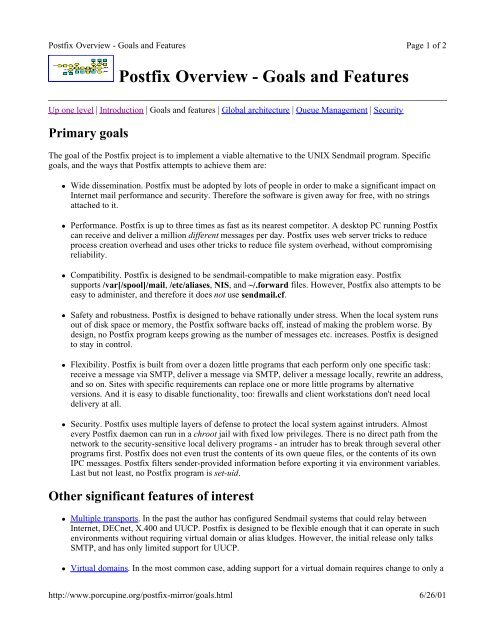Postfix Overview - Introduction - SCN Research
Postfix Overview - Introduction - SCN Research
Postfix Overview - Introduction - SCN Research
You also want an ePaper? Increase the reach of your titles
YUMPU automatically turns print PDFs into web optimized ePapers that Google loves.
<strong>Postfix</strong> <strong>Overview</strong> - Goals and Features<br />
Page 1 of 2<br />
<strong>Postfix</strong> <strong>Overview</strong> - Goals and Features<br />
Up one level | <strong>Introduction</strong> | Goals and features | Global architecture | Queue Management | Security<br />
Primary goals<br />
The goal of the <strong>Postfix</strong> project is to implement a viable alternative to the UNIX Sendmail program. Specific<br />
goals, and the ways that <strong>Postfix</strong> attempts to achieve them are:<br />
• Wide dissemination. <strong>Postfix</strong> must be adopted by lots of people in order to make a significant impact on<br />
Internet mail performance and security. Therefore the software is given away for free, with no strings<br />
attached to it.<br />
• Performance. <strong>Postfix</strong> is up to three times as fast as its nearest competitor. A desktop PC running <strong>Postfix</strong><br />
can receive and deliver a million different messages per day. <strong>Postfix</strong> uses web server tricks to reduce<br />
process creation overhead and uses other tricks to reduce file system overhead, without compromising<br />
reliability.<br />
• Compatibility. <strong>Postfix</strong> is designed to be sendmail-compatible to make migration easy. <strong>Postfix</strong><br />
supports /var[/spool]/mail, /etc/aliases, NIS, and ~/.forward files. However, <strong>Postfix</strong> also attempts to be<br />
easy to administer, and therefore it does not use sendmail.cf.<br />
• Safety and robustness. <strong>Postfix</strong> is designed to behave rationally under stress. When the local system runs<br />
out of disk space or memory, the <strong>Postfix</strong> software backs off, instead of making the problem worse. By<br />
design, no <strong>Postfix</strong> program keeps growing as the number of messages etc. increases. <strong>Postfix</strong> is designed<br />
to stay in control.<br />
• Flexibility. <strong>Postfix</strong> is built from over a dozen little programs that each perform only one specific task:<br />
receive a message via SMTP, deliver a message via SMTP, deliver a message locally, rewrite an address,<br />
and so on. Sites with specific requirements can replace one or more little programs by alternative<br />
versions. And it is easy to disable functionality, too: firewalls and client workstations don't need local<br />
delivery at all.<br />
• Security. <strong>Postfix</strong> uses multiple layers of defense to protect the local system against intruders. Almost<br />
every <strong>Postfix</strong> daemon can run in a chroot jail with fixed low privileges. There is no direct path from the<br />
network to the security-sensitive local delivery programs - an intruder has to break through several other<br />
programs first. <strong>Postfix</strong> does not even trust the contents of its own queue files, or the contents of its own<br />
IPC messages. <strong>Postfix</strong> filters sender-provided information before exporting it via environment variables.<br />
Last but not least, no <strong>Postfix</strong> program is set-uid.<br />
Other significant features of interest<br />
• Multiple transports. In the past the author has configured Sendmail systems that could relay between<br />
Internet, DECnet, X.400 and UUCP. <strong>Postfix</strong> is designed to be flexible enough that it can operate in such<br />
environments without requiring virtual domain or alias kludges. However, the initial release only talks<br />
SMTP, and has only limited support for UUCP.<br />
• Virtual domains. In the most common case, adding support for a virtual domain requires change to only a<br />
http://www.porcupine.org/postfix-mirror/goals.html<br />
6/26/01
















